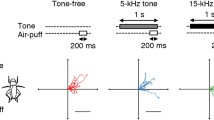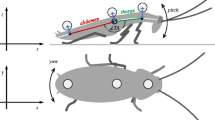Abstract.
Tethered walking crickets often respond to single wind puffs (50 ms duration) directed from 45° left or right to the abdominal cerci with a short running bout of about 300 ms, followed by normal locomotion. To test for an effect of the current behavioral state on the running response, we applied wind stimuli when the insect attained a predefined translatorial and/or rotatorial velocity during spontaneous walking. The latency, duration, and velocity profile of the running bout always proved to be constant, representing a reflexlike all-or-nothing reaction, while the probability of this response was low after even brief standing and increased with the forward speed of spontaneous walking at the moment of stimulation. In contrast, the current rotatorial speed did not affect the stimulus response.
Similar content being viewed by others
Author information
Authors and Affiliations
Additional information
Received: 26 August 1998 / Accepted in revised form: 2 December 1998
Rights and permissions
About this article
Cite this article
Gras, H., Bartels, A. Effects of Spontaneous Locomotion on the Cricket's Walking Response to a Wind Stimulus. Naturwissenschaften 86, 242–246 (1999). https://doi.org/10.1007/s001140050608
Issue Date:
DOI: https://doi.org/10.1007/s001140050608




